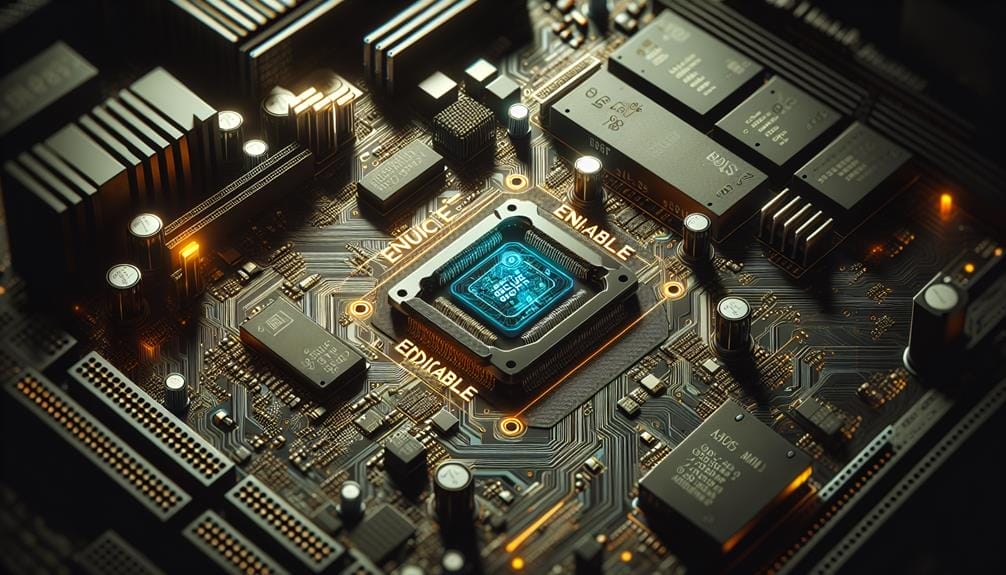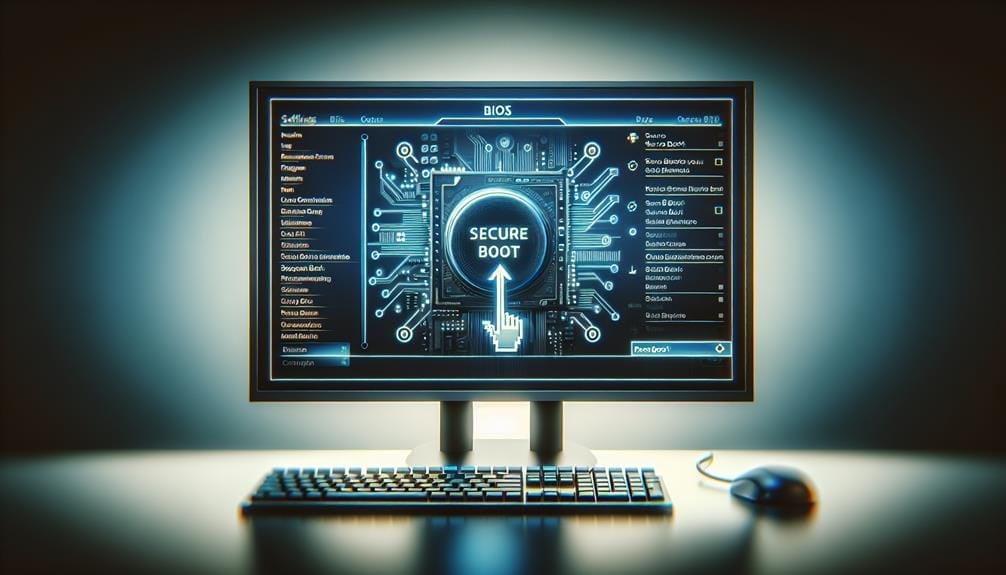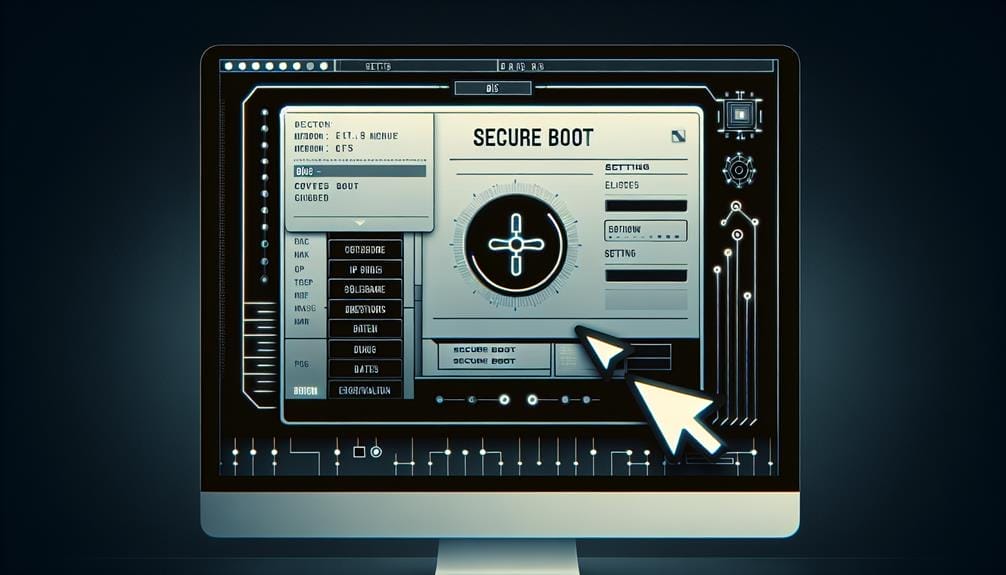Unlocking BIOS Secrets: Enable or Disable Secure Boot

In the field of cybersecurity, Secure Boot acts as an essential security feature within the BIOS, guaranteeing that illegitimate software cannot compromise the security of the operating system.
The decision to enable or disable this feature can have significant implications for system performance and compatibility with different software platforms.
As we navigate through the complexities of BIOS settings, it becomes essential to understand the impact of toggling Secure Boot and the scenarios in which it may be necessary to make adjustments.
By delving into the intricacies of this pivotal BIOS feature, we open the door to a deeper understanding of system security and optimization.
Key Takeaways
- Secure Boot is a security setting in BIOS that checks if the operating system software is signed by a trusted vendor.
- It was introduced with UEFI BIOS in Windows 8.
- The main purpose of Secure Boot is to protect against malware infections and rootkits.
- Secure Boot should not be disabled unless necessary.
What Is Secure Boot in Bios?

Secure Boot in BIOS is a security feature designed to verify the integrity and authenticity of the operating system during the boot process. This feature ensures that only trusted software is loaded, protecting the system against malware and unauthorized operating systems. The benefits of Secure Boot include enhanced system security and the prevention of low-level attacks during the boot process.
However, users may encounter issues with Secure Boot, such as compatibility problems with certain operating systems or drivers. To troubleshoot Secure Boot issues, users can try updating the BIOS to the latest version, checking for secure boot-related settings, and verifying the digital signatures of the operating system.
Disabling Secure Boot should only be considered as a last resort, and it is recommended to seek assistance from technical support or refer to the system’s documentation when troubleshooting Secure Boot issues.
Enabling/Disabling Secure Boot in BIOS
When configuring the security settings in the BIOS, one important consideration is the option to enable or disable Secure Boot.
- Peace of Mind: Enabling Secure Boot provides an additional layer of security, ensuring that only trusted operating system software is loaded during the boot process.
- Flexibility: Disabling Secure Boot may be necessary to accommodate older versions of Windows or certain Linux distributions that are not compatible with Secure Boot.
- Compatibility: Some alternative operating systems and hardware may require Secure Boot to be disabled in order to function properly.
- Risk Assessment: Carefully weigh the benefits of enhanced security with the potential limitations on system customization when deciding whether to enable or disable Secure Boot.
Opening the BIOS
Discussing security settings in the BIOS, the first step towards configuring the system involves accessing the BIOS interface, commonly referred to as ‘Opening the BIOS’. This process varies depending on the motherboard manufacturer, but it typically involves pressing a specific key (such as F2 or Delete) during system startup. Once inside the BIOS interface, users can navigate through different menus to locate the security settings, including the option to enable or disable Secure Boot. To provide a visual representation, the following table illustrates the steps involved in opening the BIOS:
| Steps | Description |
|---|---|
| Step 1 | Power on the system |
| Step 2 | Press the designated key for BIOS access |
| Step 3 | Navigate the BIOS interface |
| Step 4 | Locate the security settings menu |
| Step 5 | Access the Secure Boot option |
Troubleshooting issues with Secure Boot involves checking compatibility with the operating system, verifying digital signatures, and ensuring hardware compatibility. Potential risks of disabling Secure Boot include leaving the system vulnerable to malware attacks and unauthorized system modifications.
Finding the Boot or System Menu
Upon entering the BIOS interface, the initial step involves locating the menu related to system boot options. When finding the Boot or System Menu in the BIOS, it is important to follow these steps:
- Navigate through the BIOS interface carefully to locate the Boot or System Menu to change boot settings.
- Familiarize yourself with the layout of the BIOS menu to troubleshoot boot issues effectively.
- Take note of the different options available within the Boot or System Menu to understand the potential changes that can be made.
- Ensure that you are confident in accessing and navigating the Boot or System Menu, as any changes made here can significantly impact the system’s boot process.
Selecting the Secure Boot Option

Selecting the Secure Boot option is a crucial step in configuring the BIOS settings for system security and integrity. When choosing the Secure Boot option, it’s essential to consider BIOS compatibility and the advantages it offers. Here’s a breakdown of the BIOS compatibility and Secure Boot advantages:
| BIOS Compatibility | Secure Boot Advantages |
|---|---|
| UEFI BIOS is required for Secure Boot to function properly. | Secure Boot protects against malware infections and rootkits by verifying the digital signature of the OS. |
| Some older hardware may not support Secure Boot, requiring a BIOS update for compatibility. | It provides a layer of security by only allowing digitally signed OS loaders and drivers to execute during the boot process. |
| Not all operating systems are compatible with Secure Boot, so it’s important to verify compatibility before enabling it. | Secure Boot helps prevent unauthorized access and ensures the integrity of the boot process. |
Understanding BIOS compatibility and the advantages of Secure Boot is essential for making informed decisions when configuring system security settings.
Enabling or Disabling Secure Boot
Enabling or Disabling Secure Boot is a critical step in configuring BIOS settings for system security and integrity.
Pros and cons of using Secure Boot in BIOS:
- Pros: Protects against malware infections and rootkits, enhances system security.
- Cons: May limit the ability to boot alternative operating systems, potential compatibility issues with certain software or hardware.
Common issues and troubleshooting tips for Secure Boot in BIOS:
- Issue: Incompatibility with Linux distributions.
- Troubleshooting: Consider disabling Secure Boot or look for Linux distributions with Secure Boot support.
- Issue: Difficulty booting older versions of Windows.
- Troubleshooting: Disable Secure Boot temporarily to boot the older Windows version, then re-enable it.
Carefully weighing the benefits and drawbacks of Secure Boot and being aware of potential compatibility issues can help users make informed decisions when configuring this critical BIOS security feature.
Saving Changes and Exiting BIOS

After carefully considering the benefits and potential compatibility issues of Secure Boot in BIOS, the next critical step is to save any changes made and exit the BIOS settings. Upon enabling or disabling Secure Boot, it is imperative to ensure that the changes are properly saved. This action will commit the alterations to the BIOS, allowing the system to boot with the new settings in place. To troubleshoot Secure Boot, it is crucial to understand the process of saving changes and exiting BIOS. The table below outlines the steps to save changes and exit the BIOS settings.
| Steps to Save Changes and Exit BIOS |
|---|
| 1. Navigate to the Exit menu. |
| 2. Select the option to Save Changes. |
| 3. Confirm the selection. |
| 4. Choose the option to Exit BIOS. |
When to Disable Secure Boot
Disabling Secure Boot in the BIOS should be carefully considered and only undertaken when necessary for specific system requirements or compatibility with alternative operating systems.
- Legacy Operating Systems: Disabling Secure Boot may be necessary to boot older versions of Windows that do not support this security feature.
- Linux Compatibility: Some Linux distributions may encounter compatibility issues when Secure Boot is enabled, requiring its disabling for proper functionality.
- Alternative Operating Systems: Secure Boot is primarily designed for Windows, so if using alternative operating systems, such as certain Linux distributions, it may be necessary to disable it.
- Hardware Upgrades: In some cases, hardware upgrades or specific system configurations may require Secure Boot to be disabled to ensure proper functionality.
Further Reading and Discussions

Having established the circumstances warranting the consideration of disabling Secure Boot in the BIOS, it is valuable to delve into further reading and engage in discussions that expound upon the nuances of this security feature and its implications for system operations. For those seeking more in-depth knowledge and insights, the following resources and forums are recommended:
| Further Reading Resources | Forum Discussions |
|---|---|
| – UEFI BIOS Boot Mode Explained | – What Does The White Light on My Motherboard Mean? |
| – How to Change Your Boot Order in BIOS | – PC Recommendations for AutoCAD Plant 3D modeling |
| – How to Quickly Enable Virtualization in Your BIOS | – New User Introduction |
Exploring these resources and participating in relevant discussions can provide valuable information on alternative OS compatibility and the potential impact of Secure Boot on system operations.
Conclusion
In conclusion, understanding the function and management of Secure Boot in the BIOS is essential for users looking to optimize their system’s security and performance.
By following the outlined steps for enabling or disabling Secure Boot, users can make informed decisions based on their specific needs, whether it involves booting different operating systems or enhancing system security.
Further exploration of this topic can provide valuable insights into the intricacies of BIOS settings and their impact on system functionality.

